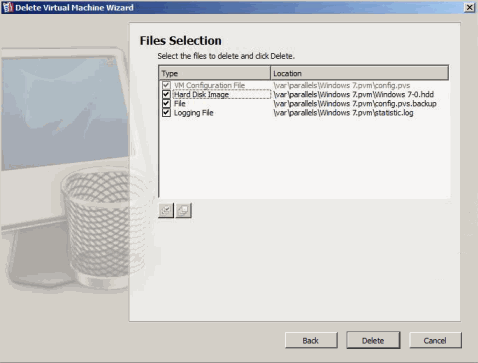Deleting and Removing a Virtual Machine
If you do not need any of your virtual machines, you can either temporarily remove or delete it from Parallels Management Console.
When removing a virtual machine from Parallels Management Console, you do not remove the virtual machine files from the Parallels server. You can easily add the removed virtual machine back to the virtual machines list with the help of Add Existing Virtual Machine Assistant. For more information about adding existing virtual machines, see Adding an Existing Virtual Machine .
Deleting a virtual machine means permanently erasing its files from the Parallels server. Make sure you transferred all the necessary data from the virtual machine before deleting it: this operation is irreversible. All the virtual machine data will be lost.
You can delete a virtual machine using Delete Virtual Machine Assistant (or Delete Virtual Machine Wizard if Parallels Management Console is installed on a Windows- or Linux-based physical computer) that finds and deletes all the virtual machine files. Or you can delete a virtual machine manually. However, we recommend that you use Delete Virtual Machine Assistant.
By default, Delete Virtual Machine Assistant removes all files that are stored in the virtual machine folder, including:
- configuration file
- virtual hard disk file(s)
- floppy disk image file(s), if any
- output files of serial and parallel ports, if any
To delete a virtual machine or remove it from the list:
- Launch Parallels Management Console.
- In the sidebar , select the virtual machine you want to delete or remove from the list.
-
Start Delete Virtual Machine Assistant by doing one of the following:
- choose Remove from the File menu
-
click
Remove
in the
Operations
section of the virtual machine
Summary
tab
Note: Before deleting a virtual machine, make sure that the virtual machine is stopped.
-
In the
Delete Options
window, select the operation you want to perform on the virtual machine.
- To delete the virtual machine, select Delete and click Continue .
-
To remove the virtual machine from the list, select
Remove
from list
and click
Remove
.
Note: If you remove the virtual machine from the list visible in Parallels Management Console, its files will not be removed from the Parallels server. You will be able to add this virtual machine back.

-
If you chose to delete the virtual machine, you would be presented with the
Files Selection
window. This window displays all the files that belong to the virtual machine.In the
File Selection
window, choose the virtual machine files to be deleted from the Parallels server and click
Delete
.
The assistant automatically selects the files that belong to the virtual machine, such as:
-
VM Configuration File
. The file has the
.pvsextension and defines hardware and resources configuration of the virtual machine. -
Hard Disk Image
. The file has the
.hddextension and represents a virtual hard disk of the virtual machine. -
Floppy Image
. The file has the
.fddextension and is a floppy disk image file. -
File
. The file has the
.DS_Storeextension and is a hidden file created by the host OS to store custom attributes of a folder. -
Logging File
. The file has the
.logextension and serves to record the data.
-
VM Configuration File
. The file has the
- Once the operation is complete, click Done to exit the assistant.
|
|
 Feedback
Feedback
|